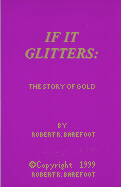![]()
![]()
![]()
![]()
A great resource for information on Gold History . . .
Click Image to Read
Back Cover Information
“IF IT GLITTERS” TABLE OF CONTENTS
|
|
|
|
“If It Glitters” is the story of gold from the time of its discovery, up to the present day. The purpose of this book is not to remove the mystique or to tarnish the glitter of gold, but rather to shed light for the layman on the histories and mysteries of gold. The view is from the eye of the beholder. The book is full of gold anecdotes from the golden goose to the Midas touch to Cleopatra’s golden fleece. For the fist time, the true story is told of Christopher Columbus’s barbaric treatment of the Indians in his pursuit of gold.
|
|
| The history of gold in North America is tracked from the Indians to the early Spanish explorers to the gold rushes of the wild west. The history of the metallurgical extraction of gold is traced from ancient times to the time of the famous Patio Process of the Spaniards to the last development, the cyanide process in the nineteenth century. The author, who as numerous international patents and who has 30 years hands on experience in gold extraction, also proposes the process, differential charge recovery system, for the environmentally friendly extraction of gold into the 21st century.
For several years Mr. Barefoot worked first in the petroleum industry successfully chemically inducing wells to produce more oil, and then in the mining industry where he successfully developed new methods to recover metals from ores. It was by accident, that one day he discovered that most gold in ores takes the form of 18-micron (less than one thousandth of an inch) octahedral (8 sided) crystals. Of interest, the form of preference for crystallization at high temperatures and pressures, such as is found in the bowels of the Earth, is octahedral crystallization. The “gold experts” of the day disputed his claim until he melted the crystals into gold bars. The crystals can now be seen in metallurgical books. The recognition of this size (3 times smaller than that which could be seen by the human eye) and the shape led Barefoot to conclude that none of this gold could be recovered by any conventional gravity system. Barefoot then led a team which used the centrifugal force of mini swirls (100’s of G’s) to force the gold crystals (on which he put a positive electrical charge) close enough to a negatively charged collector so that the gold would be entrapped by thousands of G’s of force. The development of this new technology into a patentable entity too over 10 years of frustrating research with field-testing all over North and Central America. Equally frustrating is the 8 years that have elapsed since the first patent application. The gold industry’s extraordinary high rate of failure |
combined with the fact numerous “experts” in the industry, who have a vested interest in maintaining the status quo, inhibited the exploitation of the technology.
Historically, this reluctance to accept new technology will eventually be overcome as the technology gradually becomes accepted. The efforts to succeed have continued to the point where chief executives of the world’s largest mining companies are now reviewing the technology. The day will soon come when the recovery of most of the gold, diamonds and other metals will be accomplished using this new technology. Of interest, this same process has allowed the author to extract gold from ores that apparently contained no gold by fire assay, but which in fact may prove to be the most massive amount of gold ever discovered, hundreds of times all of the gold ever recovered in the history of mankind. The author uses scientific records and arguments and explains how the assays have been proven to be incorrect. Further more, the recorded recovery of gold in the hand from numerous of these ore deposits, proves that the authors theory is correct and that the dozens of companies currently trying to recover the unassailable gold from these ores are on the right track. The author believes that gold also plays a crucial part in human health. In many countries people eat gold, usually in the form of thin crumbly sheets added to sandwiches, because of the belief that it is healthful. Gold is everywhere and finds itself being absorbed by plants that people eat. The author was once asked to bid on a California project to remove gold from the ash of human excretion. It takes 100 tons of human excretion to produce one ton of ash evaluated at one third of an ounce of gold. In short, this messy business is not very profitable but it does demonstrate that the human body absorbs substantial gold, which must serve some useful purpose, the description of which may one day lead to a Nobel Prize. |
|
|
|
